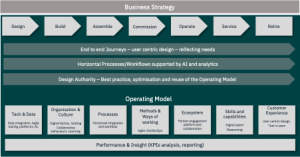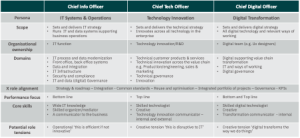About cookies on this site Our websites require some cookies to function properly (required). In addition, other cookies may be used with your consent to analyze site usage, improve the user experience and for advertising. For more information, please review your options. By visiting our website, you agree to our processing of information as described in IBM’sprivacy statement. To provide a smooth navigation, your cookie preferences will be shared across the IBM web domains listed here.
Aerospace and Defence
Architecting Digital Transformation Organisations and Technology Leadership
18 May, 2022 | Written by: Richard Davies
Categorized: Aerospace and Defence
Share this post:
The context of digital transformation in Defence
Digital organisations in defence need to embrace the following dimensions of transformation (see IBM Blog).
- Meeting the evolving digital needs – Industry 4.0 meeting Defence 4.0
- Making ecosystems work – collaborative platforms, integrated solutions and associated commercials (IP, Security)
- Delivering on new agile ways of working – culture, human centered design, DevSecOps
- Building and integrating platforms consistently – horizontal workflows, secure cloud/edge, digital twin/synthetic testing
- Creating a digital operating model – new skills, aligned process organisational structures and capabilities
Increasingly, organisations are asking about how to create real transformation with modern technologies. Many are asking questions about how they should organise themselves to deliver that.
Designing a digital organisation
Conway’s law states organisations design systems that mirror their own communication structure.
“Any organization that designs a system (defined broadly) will produce a design whose structure is a copy of the organization’s communication structure.”
— Melvin E. Conway, 1967
So functional silos around a particular asset type (e.g. types of vehicle or aircraft) will lead to the design of a solution around that asset. If your marketing and service solution works on a regional basis, it’s hard to create a global capability. The answer is to design your software architecture to reflect the way you want to run your operation and then define your organisation. Horizontal process integration is key to realise enterprise benefits across differing assets, so that is the way you must define your technology architecture; then change the organisation.
So the challenges are numerous. Engaging users in user centric design to disrupt and challenge institutional ways of working is hard because of legacy thinking and executive ownership of domains. Further, horizontal processes involve defining and establishing new ways of working; managing end to end processes and life cycles. If horizontal processes integrate multiple assets and data sets, decisions need to be made with accurate and compatible data. Sharing and aggregating data can create security and IPR issues. For example, who owns the data and what are rights to its use. Is there IPR in data (e.g. engineering designs) that are required to be managed with sensitivity. All of these types of issue need resolving.
Key to defining the right organisation is the definition of and Operating Model, that reflects capabilities delivering across the value chain. In defining the operating model, we would use IBM’s Design Thinking to define user journeys to reimagine the key processes (e.g. horizontal operations cutting across ecosystem of partners). Journeys are aligned to solutions, data, skills and capabilities. In this way, the operating model is a key tool to articulate the future state, as defined by the business strategy.

Figure 1 – A conceptual Digital Operating Model applied to Defence
Importantly, a Design Authority applies governance around the elements within the operating model to drive best practice and optimisation of tooling, designs, processes and architectures for example. In addition, projects need to align to the operating model so that the right design, build and run capabilities are built. Projects must be aligned to business strategy and relentlessly tracked against outcomes/business value, with all projects managed as an integrated portfolio. IBM has a ‘Value Orchestration’ proposition, in which projects portfolios are assessed for value and strategic alignment and, in necessary, the mechanics of running large and complex portfolios can be implemented.
Determining IT leadership
Given this context of complex change in defence, there are questions about the type of IT and technology leadership that is required. Individuals that need to sponsor and drive the change to enable the business. The first question should be about strategy; is your objective to retain the status quo or is it to challenge and drive radical transformational change. There is then a myriad of questions that might shape the role and personality of leadership. These are presented in the slider diagram below by means of illustration of some of the dimensions. Key questions are for the wider leadership, principally the business; do they understand the benefits of proposed projects sufficiently to invest in them, and do they believe that they can be delivered by the technical leadership? Typically for clients IBM would undertake and assessment to link strategy to the types of challenges facing technology leadership.

Figure 2 – The dimensions that might influence the type of technology leader required
Historically, the two core technology roles are those of the Chief Information Officer (CIO) and Chief Technology Officer (CTO). Chief Information Officers (CIOs) are generally focused on IT systems and operations, whereas Chief Technology Officers (CTOs) are typically addressing on wider technologies, for example as the means of production and the accommodation of technology in digital customer products.
IBM research recently identified some CTO and CIO ‘mandates’ these can be broadly categorised as consisting of a mix of the following dimensions:
- Inward or outward looking
- Focused on business continuity and operations or innovation
- Maximising existing investment or driving IT change
- High or low levels of collaboration (internally and with the partner ecosystem)
- A board advisor or alternatively more operational within and across functions
About a quarter of CTOs and CIOs were visionaries who combined the CIO and CTO role; this perhaps reflects the convergence of digital in IT and in products (e.g. Digital Applications, IOT) and production (e.g. Manufacturing 4.0). Because of the pace of change and this convergence, many organisations are appointing Chief Digital Officers, confusing with the same acronym with Chief Data Officers. Chief Digital Officers (referred to as CDOs here) are tasked with the digital transformation agenda. Just what roles are created depends on the magnitude of the challenges in terms of scale and complexity. If data is a fundamental enterprise challenge, that might warrant a Chief Data Officer too! It’s important to define unambiguous roles where possible, but with the understanding there will be overlap between a CTO and a CIO for example. It is increasingly important to select individuals who complement each other and who can work collaboratively as a team, but also with the business, and the ecosystem of partners.
Defining roles and responsibilities can be difficult. It revolves around the types of organisations and individuals concerned. The table below gives an indication of generic role architypes for the CIO, the CTO and the CDO. These are, of course, subject to debate.

Figure 3 – Role architypes for the CIO, the CTO and the CDO
The key observation are potential areas of demarcation and overlap. Interestingly too are the areas of potential tension, perhaps derived from stereotyping! CIOs might be seen as driving efficiency whereas the CTO is driving technical innovation. The CDO might be perceived as owning the transformation. Reporting hierarchies might help resolve this e.g. the CDO reporting to the CTO.
Call to Action
Key points to consider:
- Define your software architecture to support the way you want to operate in a future state which should be clearly defined in your business strategy.
- Then create a user centric operating model, using journeys, to define the skills, capabilities, and technologies you need to support the business strategy.
- Are the strategic imperatives understood and does the business leadership appreciate the benefits case sufficiently to sponsor investment.
- Use a Design Authority to support the elements of the Operating Model to ensure best practice, optimisation and reuse.
- Ensure that all your projects are managed as an integrated portfolio and are delivering strategic value.
- Provide clarity on what ‘mandate’ is required from your technology leadership.
- Your IT and technology leadership requires personalities, skills and roles that must be aligned to the type and scale of the change.
- Fundamentally, delivering digital change requires collaboration within teams, across functions and externally within an ecosystem.
References and further reading
Digital Transformation in Defence – Balancing Strategic & Tactical
Defence data – a new strategic asset
Manufacturing 4.0 meets Defence 4.0

Richard Davies
Enterprise Strategy - Defence Lead IBM
More Aerospace and Defence stories
By Col Chambers and Ed Gillett on 5 February, 2025
Preparing for the defence of the Realm
In light of current conflicts, the UK is now faced with real-world military decisions that will affect our immediate future. Ed Gillett and Col Chambers assert that industry and government must switch to a readiness mindset before the European post-war peace shatters. “My vision for the British Army is to field fifth-generation land […]



























